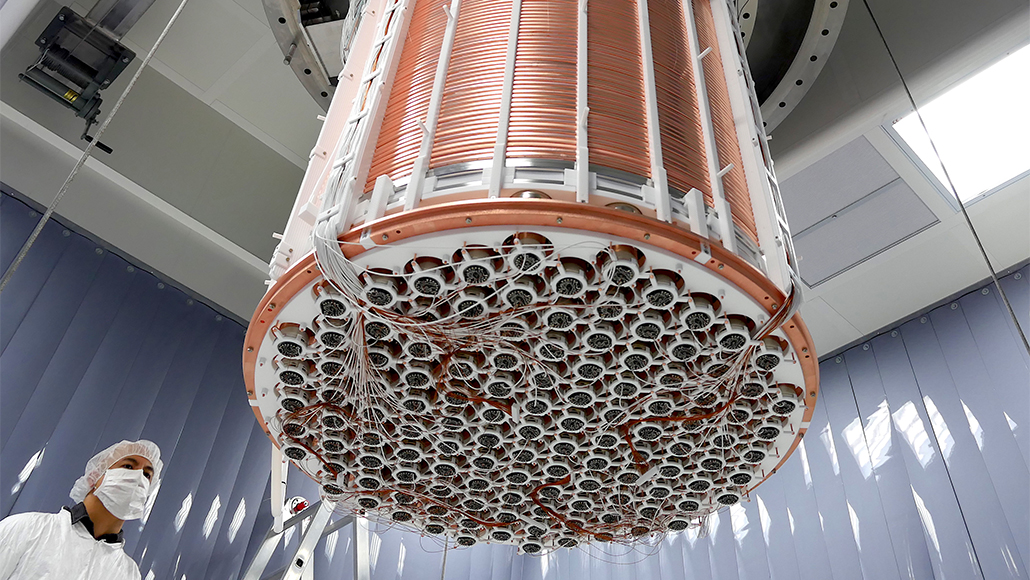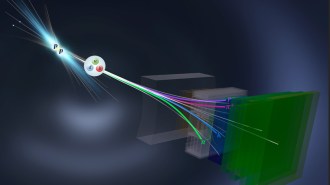An unexpected result from a dark matter experiment may signal new particles
The XENON1T experiment spotted an excess of events at low energies

Scientists with the XENON1T experiment (shown) observed extra blips in their dark matter detector at low energies. That could be a sign of new particles such as solar axions or from tiny amounts of radioactive tritium, the researchers say.
XENON Collaboration
- More than 2 years ago
An experiment searching for cosmic dark matter may have finally detected something. But it’s not dark matter.
Scientists with the XENON1T experiment reported data June 17 showing an unexpectedly large number of blips within their detector. “We observe an excess … and we don’t know what it is,” said physicist Evan Shockley of the University of Chicago, who described the result during a virtual seminar.
The blips could be explained by weird new particles called solar axions, or unexpected magnetic properties for certain known particles, neutrinos, the researchers propose.
Or the excess might instead be the result of a more banal scenario: A tiny amount of radioactive tritium could have found its way into the detector. None of the possibilities would explain the nature of dark matter, an unseen substance in the universe that helps stars cling to their galaxies and explains how structures formed in the early universe.
The XENON1T detector, located deep underground at the Gran Sasso National Laboratory in Italy, searched for interactions of dark matter particles within a large vessel filled with liquid xenon, running from 2016 to 2018. Until now, the researchers have come up empty (SN: 5/28/18). But in the newest analysis of the data, they saw something unexpected. When looking for signs of electrons recoiling as other particles slammed into them, the team observed extra recoils of electrons at low energies, well beyond the number predicted by standard physics. Normal particle interactions should have produced around 232 electron recoils at low energy, but the researchers saw 285 — an excess of 53.
Sign up for our newsletter
We summarize the week's scientific breakthroughs every Thursday.
“That’s exciting,” says theoretical physicist Dan Hooper of Fermilab in Batavia, Ill. “But sadly, I think it gets a little less exciting when you dig into it.” That’s because the most interesting explanations seem to be mostly ruled out by other types of measurements.
The XENON1T team suggested that the low-energy events could be due to solar axions, hypothetical particles with no electric charge that could be produced in the sun. But if those particles exist, they would also stream out from other stars, taking energy with them and causing the stars to cool off faster than observations suggest.
Another possible explanation for the extra events is impact from lightweight particles called neutrinos. If neutrinos have a magnetic moment — meaning that they act like tiny magnets — the particles would interact more strongly with electrons, resulting in more recoils. That explanation, likewise, is difficult to reconcile with what scientists observe in the cosmos, including how dead stars called white dwarfs cool.
For either of those proposed explanations to work, there would have to be something not fully understood about the previous stellar-cooling observations. And neither possibility would explain the existence of dark matter. While other varieties of axions could make up dark matter (SN: 4/9/18), XENON1T can detect only solar axions that would be too massive to fill that role. However, the existence of solar axions would help explain another long-standing puzzle of physics: why one force of nature, called the strong nuclear force, obeys a rule known as CP symmetry, unlike other interactions.
Alternatively, the detector might contain a minute amount of tritium, a radioactive form of hydrogen with two neutrons in its nucleus. That tritium could have been trapped within the materials that make up the detector, and may have slowly leaked out. When tritium atoms decay, they emit electrons, which could be responsible for the signature seen by XENON1T. This explanation wouldn’t reveal anything new about the universe, but it would be the first time that a detector of this type was sensitive enough to spot such tiny amounts of tritium.
For dark matter experiments that are searching for extremely feeble signatures, even that would be a step forward, Hooper says. “This is kind of what progress looks like.”







